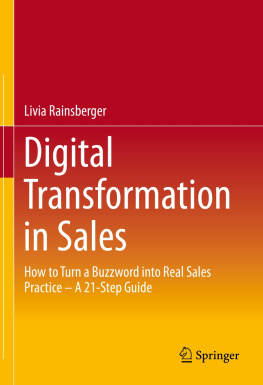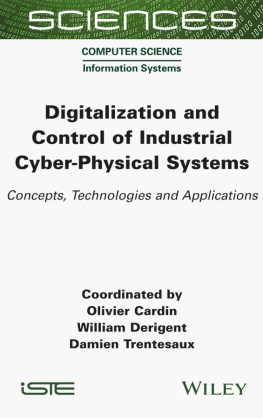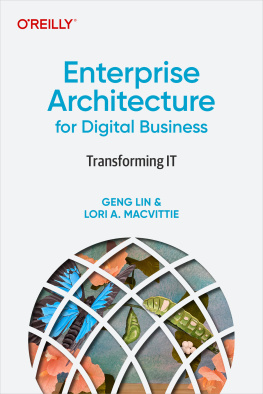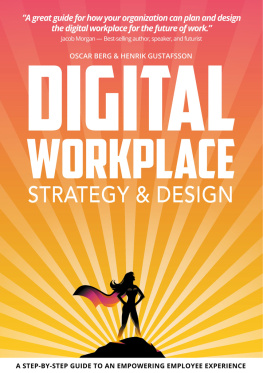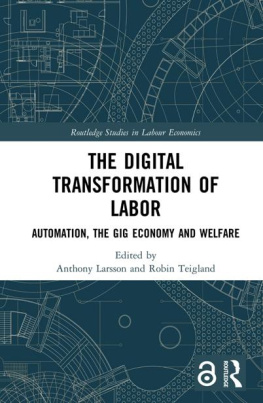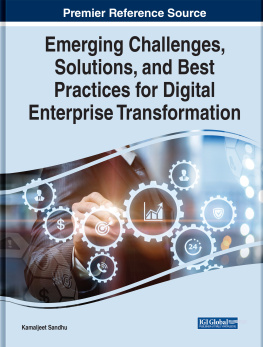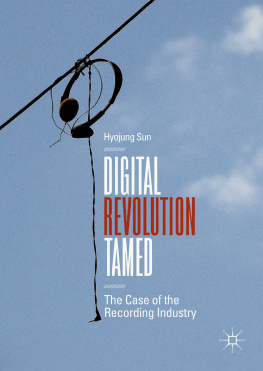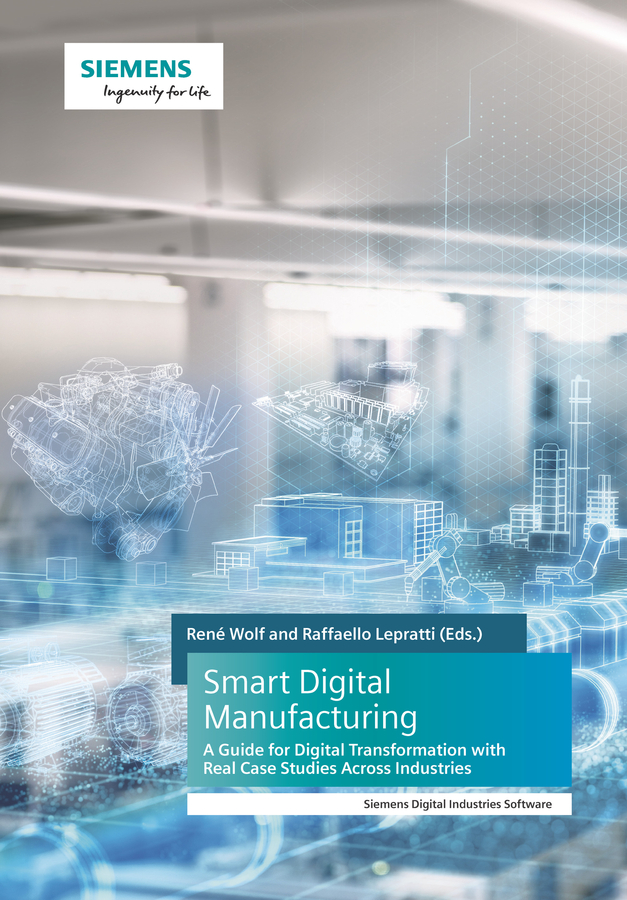
Table of Contents
List of Illustrations
- Chapter 1
- Chapter 2
- Chapter 3
- Chapter 5
- Chapter 6
- Chapter 7
- Chapter 8
- Part 2
Guide
Pages
Smart Digital Manufacturing
A Guide for Digital Transformation with Real Case Studies Across Industries
Edited by Ren Wolf and Raffaello Lepratti

Authors
Ren Wolf
Siemens Digital Industries Software
Manufacturing Operations Management
Gleiwitzer Strae 555
90475 Nrnberg
Germany
Raffaello Lepratti
Siemens Digital Industries Software
Manufacturing Operations Management
Gleiwitzer Strae 555
90475 Nrnberg
Germany
All books published by WileyVCH are carefully produced. Nevertheless, authors, editors, and publisher do not warrant the information contained in these books, including this book, to be free of errors. Readers are advised to keep in mind that statements, data, illustrations, procedural details or other items may inadvertently be inaccurate.
Library of Congress Card No.:
applied for
British Library CataloguinginPublication Data
A catalogue record for this book is available from the British Library.
Bibliographic information published by the Deutsche Nationalbibliothek
The Deutsche Nationalbibliothek lists this publication in the Deutsche Nationalbibliografie; detailed bibliographic data are available on the Internet at .
2021 WILEYVCH GmbH, Boschstr. 12, 69469 Weinheim, Germany
All rights reserved (including those of translation into other languages). No part of this book may be reproduced in any form by photoprinting, microfilm, or any other means nor transmitted or translated into a machine language without written permission from the publishers. Registered names, trademarks, etc. used in this book, even when not specifically marked as such, are not to be considered unprotected by law.
Print ISBN: 9783527348626
ePDF ISBN: 9783527830947
ePub ISBN: 9783527830954
Cover DesignSchulz Grafik Design, Fugnheim, Germany
Preface
Executive Summary
As the world progresses toward Industry 4.0, how can your manufacturing concern successfully navigate your unique digital journey? In our conversations with manufacturers from across the globe and the industrial spectrum, Siemens has heard a sweeping array of thoughts about digitalization, Industry 4.0, the smart factory and related concepts. To some, digitalization is a golden opportunity; to others, it is a necessary evil. But to optimist and pessimist alike, there seems to be widespread puzzlement over the practical details of digitalization. To many manufacturers, digital transformation is a vague and confusing concept they nevertheless must grapple with in order to survive the Fourth Industrial Revolution.
The proliferation of digital manufacturing technologies adds to the confusion, leaving many manufacturers perplexed and unprepared, with little real insight into how emerging technologies can help them sustain a competitive edge in their markets.
Yet along with the confusion and challenges, digitalization also presents manufacturers with a great opportunity to grow their competitiveness, profitability, and responsiveness to consumer demand. More than that, digital transformation for many companies is evolving from an opportunity to an imperative, especially considering unprecedented world events (say natural disasters, global financial crisis, and disruptions due to global pandemics). Supply chain disruptions, rebalancing of manufacturing hubs, a greater need for remote interaction with manufacturing operations, and other impacts of global crises are occurring on an extraordinary scale, driving many toward accelerated adoption of digital technologies. Manufacturers whose products have become scarce during a global crisis are learning new ways to rapidly increase capacity. Manufacturers who have experienced great drops in product demand during a global crisis are learning new ways to agilely repurpose their idle plants and lines. In all cases, digital technologies are critical to successfully piloting through uncertain times.
In the midst of these complexities, challenges and opportunities, Siemens has found a unique position from which to help because of our multiple roles in the manufacturing space. On one hand, as a digital industries software provider, we are deeply involved in various business conversations with manufacturers. We have listened carefully to your voices, issues, concerns, and challenges. We are intimately acquainted with the difficulties as well as the benefits of implementing digital solutions, having assisted manufacturers across the globe on this journey. On the other hand, because Siemens is a manufacturer, we have experience digitalizing our own factories and that has given us an even closer, direct experience of all that digitalization entails. We want to share the hardearned knowledge we have gained, not only as we have innovated a broad array of digital technologies, but more importantly as we have successfully implemented them for the full spectrum of manufacturing enterprises around the globe including our own.
We have set out in this book to effectively convey our knowledge and experience through a concept we call Manufacturing 4.x for Smart Digital Manufacturing, a stepwise approach to realizing the promise of the Fourth Industrial Revolution. The Manufacturing 4.x Smart Digital Manufacturing roadmap provides guidance and enables lowrisk, highreward adoption of new manufacturing software technologies through a series of tippingpoint investment decisions that result in optimized manufacturing performance.
On a deliberately practical level, Manufacturing 4.x for Smart Digital Manufacturing helps manufacturers across industries to optimize their technology adoption based on returnoninvestment ( ROI ), risk and relative competitive performance. The socalled tipping points are the points at which manufacturers should switch to a new generation of technologies, with each industry having unique considerations for their optimal path. This book focuses especially on tipping points for manufacturing operations, the critical domain where virtual and real production converge.
If this book fulfills its mission, our readers will gain a clear understanding of what digital technology has to offer them, and how and when to invest in these essential components of tomorrow's factories.
A Note to the Industry Analyst
Though this book's target readership is the manufacturing engineer, we have written it in a way that we anticipate will be helpful to analysts covering digitalization especially manufacturing operations management ( MOM ). The Manufacturing 4.x for Smart Digital Manufacturing framework is designed to be useful across various technology platforms, industries and types of manufacturing.
The book is not meant to prescribe any particular vendor choices. Instead, it communicates Siemens' perspective on how manufacturing leaders should create their digitalization roadmap in a very practical way. As industry thought leaders, analysts need to couple the practical with the visionary. We hope that our forwardlooking way of evaluating technologies and their adoption will help you make that connection. We want to prepare manufacturers to anticipate the requirements of their customers and identify the right digital investment opportunities, the ones that will enable them to thrive in these new and emerging market conditions.
Next page

